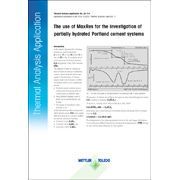The Use of MaxRes for the Investigation of Partially hydrated Portland Cement Systems
In troduction
troduction
In the cement chemistry the following symbols are used for simplicity:
A for Al2O3 , C for CaO, H for H2O, S for SiO2 and S for SO3. For example, tricalcium aluminate, 3CaO.Al2O3 becomes C3A and gypsum, CaSO4.2H2O, becomes CSH2.
The addition of water to Portland cement initiates the setting or hardening reaction, which binds the whole mass together. The hydration of Portland cement leads to the formation of different hydrates and is a very complicated process:
- Portland cement contains various components that take up water of crystallization at different rates.
- Many different hydrates, some of which are not stoichiometric, are formed.
- The degree of crystallinity of the hydrates is low.
In the first few hours after mixing water with Portland cement, C3A reacts rapidly with the formation of a number of different calcium aluminum hydrates:
- 3CaO.Al2O3.6H2O (C3AH6),
- 2CaO.Al2O3.8H2O (C2AH8) and
- 4CaO.Al2O3.19H2O (C4AH19)
The presence of calcium and sulfate in the aqueous phase (dissolved gypsum) causes C3A to hydrate to ettringite (C6AS3H32):
3CaO.Al2O3 +3CaSO4.2H2O+26H2O⇒6CO.Al2O3.3SO3.32H2O
C3A+3CSH2+26H ⇒ C6AS3H32
At the same time, a small amount of colloidal calcium silicate gel (CSH) is formed from the C3S.
C3S+nH2O ⇒ C3S.nH2O (gel)
The interpretation of the thermogravimetric curves in the early stages of this hydration is made more difficult because the decomposition temperatures of CSH, ettringite and calcium sulfate dihydrate lie close together.
The thermogravimetric measurements were performed with a METTLER TOLEDO TGA/SDTA850. The adaptive event-controlled heating rate option (MaxRes [3 - 5]) was used to improve the separation of the dehydration processes.
| UserCom | | Page | | Keywords |
| UserCom 11 | 15 | C3A, hydration |
The use of MaxRes for the investigation of partially hydrated Portland cement systems | Thermal Analysis Application No. UC 114 | Application published in METTLER TOLEDO Thermal Analysis UserCom 11